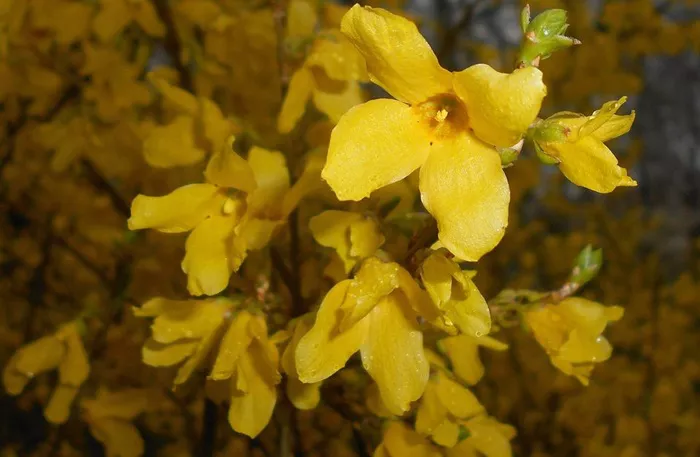Forsythia, with its vibrant yellow blooms, is a harbinger of spring. These flowers burst into color when most plants are still dormant, making them a beloved addition to gardens. Understanding their lifespan can help gardeners plan their landscapes. This article delves into the duration of forsythia flowers, exploring factors that influence their longevity and offering tips to maximize their beauty.
The Lifespan of Forsythia Flowers
Forsythia flowers typically last for about two to three weeks. This period can vary depending on several factors, such as weather conditions, plant health, and cultivation practices. Their bright yellow blossoms emerge early in spring, often before leaves appear on other trees and shrubs. This brief yet stunning display makes forsythia a symbol of renewal and the arrival of warmer days.
Factors Affecting Flower Duration
Weather Conditions
The weather plays a significant role in determining how long forsythia flowers last. Ideal conditions include mild temperatures and moderate sunlight. Prolonged periods of frost or extreme cold can damage buds and shorten the flowering period. Conversely, unseasonably warm temperatures may cause flowers to open too quickly and fade faster. Rainy weather can also impact the longevity of forsythia blooms, as excessive moisture may lead to fungal infections or cause petals to fall prematurely.
Plant Health
Healthy forsythia plants produce more robust and longer-lasting flowers. Regular pruning helps maintain the plant’s vigor by removing dead or overcrowded branches, allowing more energy to be directed towards flower production. Proper soil nutrition is also crucial. Forsythias thrive in well-drained soil with a neutral to slightly acidic pH. Adding organic matter, such as compost, can improve soil structure and provide essential nutrients that support healthy growth and extended flowering.
Cultivation Practices
The way forsythia is cultivated can significantly influence flower longevity. Planting in a location that receives full sun to partial shade is optimal. Forsythias need at least six hours of sunlight per day to produce their best blooms. Adequate spacing between plants ensures good air circulation, reducing the risk of disease. Watering is another important aspect. While forsythias are relatively drought-tolerant once established, they benefit from consistent moisture during the flowering period. Avoid overwatering, as this can lead to root rot and other issues.
Maximizing Flower Lifespan
Pruning Techniques
Pruning is a key practice for extending the flowering period of forsythia. The best time to prune is immediately after the flowers have faded. This allows the plant to focus on producing new growth and buds for the following year. Remove about one-third of the oldest branches, cutting them back to the base. This encourages the development of new, healthy shoots that will produce more flowers. Avoid heavy pruning in late summer or fall, as this can remove potential flower buds for the next spring.
Fertilization
Fertilizing forsythia plants can enhance their overall health and extend flower longevity. Use a balanced, slow-release fertilizer in early spring, just as new growth begins to emerge. Avoid high-nitrogen fertilizers, as these can promote excessive foliage growth at the expense of flowers. Organic fertilizers, such as well-rotted manure or bone meal, are excellent choices. They provide a steady supply of nutrients that support healthy root development and flower production.
Pest and Disease Management
Protecting forsythia from pests and diseases is essential for maintaining flower longevity. Common pests include aphids and spider mites, which can damage buds and flowers. Regularly inspect your plants for signs of infestation and treat them promptly with insecticidal soap or neem oil. Diseases such as powdery mildew and leaf spot can also affect forsythia. Ensure proper spacing and good air circulation to reduce the risk of disease. If necessary, apply fungicides according to the manufacturer’s instructions.
Forsythia Varieties and Flowering Duration
Different forsythia varieties may have slightly different flowering durations. Some cultivars, such as Forsythia × intermedia ‘Lynwood Gold’, are known for their exceptionally vibrant and long-lasting blooms. These plants often produce flowers that last closer to the three-week mark. Other varieties, like Forsythia suspensa, may have a slightly shorter flowering period but offer unique characteristics, such as cascading branches that add visual interest to the garden. When selecting forsythia for your garden, consider both the flowering duration and the plant’s overall appearance.
Extending Forsythia Beauty Beyond the Flowering Period
Even after the flowers have faded, forsythia can continue to contribute to the garden’s beauty. The plant’s bright green foliage provides a lush backdrop for other spring and summer blooms. In the fall, some forsythia varieties develop attractive fruit that can persist into winter, adding a touch of color to the landscape. By choosing a forsythia variety that offers year-round interest, you can maximize the plant’s value in your garden.
Conclusion
Forsythia flowers typically last for two to three weeks, bringing a burst of color to the early spring garden. Their lifespan is influenced by weather conditions, plant health, and cultivation practices. By providing optimal growing conditions, pruning correctly, and protecting against pests and diseases, gardeners can maximize the beauty and longevity of forsythia blooms. These vibrant flowers are a symbol of spring’s arrival and a welcome addition to any garden.


